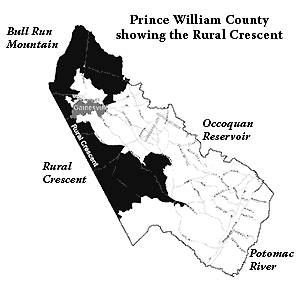The Rural Crescent
Myths & Facts
 Myth #1 - Allowing parcels in the Development Area to be developed at higher densities than equivalent parcels in the Rural Area is unfair. Myth #1 - Allowing parcels in the Development Area to be developed at higher densities than equivalent parcels in the Rural Area is unfair.
Fact - All zoning restrictions affect value of parcels. Property zoned for 4 houses/acre near I-95 will be worth more/acre than property zoned for 1 house/5 acres, or for parcels zoned for shopping center development.
The A-1 zoning in the Rural Area allows for appropriate development of private property, at a density where public services can be provided at reasonable cost to county taxpayers.
Myth #2 - There is not enough housing is available in Prince William to accommodate the need, so parcels in the Rural Area need to be rezoned to higher density.
Fact - The latest build-out analysis from the Planning Department shows that 40,000 dwelling units could be constructed under existing zoning, accommodating demand for the next 20 years. In addition, the new Land Use chapter designated specific Town Centers for additional, significant increases in density. The North Woodbridge Master Plan, approved on May 4 2010, adds up to 3,500 new homes to the Comprehensive Plan. If rezoning is required, it should occur in the Development Area.
Myth #3 - Parcels on the edge of the Rural Area could be redesignated, with no significant impact.
Fact - There will always be disputes at any boundary line. Developers will always want to buy property at low cost, then get the zoning changed in order to make windfall profits. As soon as one parcel is rezoned, adjacent property owners will clamor for another "small revision in the boundary," so they can get their windfall profit.
The rapid suburbanization of Prince William has given us many opportunities to learn from past mistakes. One clear lesson is that concentrating population density is the cost-effective way to offer public services, from sewers/schools in the 1960's to expanded public transit services tomorrow.
In contrast, sprawl creates traffic congestion and demand for services that require expensive infrastructure, forcing property tax increases so existing residents subsidize new development. There will always be developers who seek short-term profits by purchasing land at low prices, using political influence to get a rezoning with big-but-still-inadequate proffers, and shifting the long-term costs to expand roads, schools, etc. to the general public. Protecting the Rural Crescent will require eternal vigilance. |